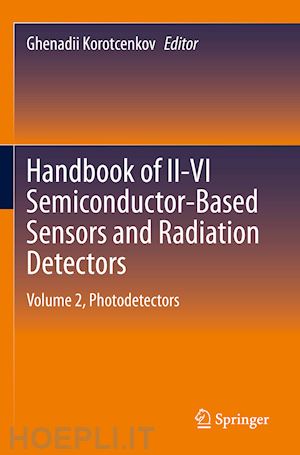

Questo prodotto usufruisce delle SPEDIZIONI GRATIS
selezionando l'opzione Corriere Veloce in fase di ordine.
Pagabile anche con Carta della cultura giovani e del merito, 18App Bonus Cultura e Carta del Docente
Three-volumes book “Handbook of II-VI Semiconductor-Based Sensors and Radiation Detectors” is the first to cover both chemical sensors and biosensors and all types of photodetectors and radiation detectors based on II-VI semiconductors. It contains a comprehensive and detailed analysis of all aspects of the application of II-VI semiconductors in these devices. The second volume “Photodetectors” of a three-volume set, focus on the consideration of all types of optical detectors, including IR detectors, visible and UV photodetectors. This consideration includes both the fundamentals of the operation of detectors and the peculiarities of their manufacture and use. In particular, describes numerous strategies for their fabrication and characterization. An analysis of new trends in development of II-VI semiconductors-based photodetectors such as graphene/HgCdTe-, nanowire- and quantum dot-based photodetectors, as well as solution-processed, multicolor, flexible and self-powered photodetectors, are also given.
Basic principles of solid state X-ray radiation detector operation .- (classification, materials, requirements, advantages of II-VI compounds, limitations, application) .- ZnSe-based radiation detectors .- (Single crystal detectors, polycrystalline detectors, design, performances) .- CdTe/CdZnTe-based radiation detectors .- (Single crystal detectors, polycrystalline and epitaxial-based detectors, design, progresses in Growth of High Quality crystals, Performances) .- X-ray and gamma imaging using II-VI semiconductor-based detectors .- (approaches, applications) .- Introduction in gas and humidity sensing .- (principles of operation, main applications) .- II-VI semiconductor-based thin film electric and electronic gas sensors .- (conductometric, QCM, SAW-based sensors, thin film and thick film technology; light activation, surface decoration, performances) .-Nanocomposite and hybrid-based electric and electronic gas sensors .- (all types of sensors based on polymer-II-VI composites, carbon-based- II-VI, and metal oxide-II-VI based composites and heterostructures) .- Nanomaterial-based electric and electronic gas sensors .- (all types of sensors based on QDs, 1D, 2D, 3D, core/shells structures) .- II-VI-based electric and electronic humidity sensors .- (all types of sensors; conventional materials; nanomaterials: QDs, 1D, 2D, 3D;) .- II-VI-based optical gas sensors .- (CdSe, CdTe, CdS, luminescence, fluorescence, fiber-optic, QDs, performances, etc.) .- Spectroscopic gas sensing systems .- (systems based on II-VI lasers) .- II-VI-based luminescence and fluorescence ion sensors .- (toxic metals, pH) .- Photoelectrochemical ion sensors .- (toxic metals, electrodes, ion-exchange reactions, applications) .- Introduction in biosensing .- (approaches,materials used, QDs, applications) .- Toxicity and biocompatibility of II-VI semiconductors .- (biocompatibility evaluation, toxicological researches, genotoxicity, cytotoxicity, photoinduced toxicity, QDs, mechanism of QDs toxicity, core-shall structures, surface treatment, ligand exchange, additional coating layers, etc.) .- Biofunctionalization of II-VI QDs .- (semiconductor/biomolecular heterojunctions, functionalization of QDs, solubilization, bioconjugation, functionalization chemistry, ligand exchange, chemical functional groups, biomolecules, limitations) .- Fluorescent biosensors based on II-VI QDs .- (principles of operation, performances, functionalization, advantages, disadvantages, applications, etc.) .- Bioluminescent biosensors based on II-VI QDs .- (principles of operation, performances, functionalization, advantages, disadvantages, applications, etc.) .- Chemiluminescent biosensors based on II-VI QDs .- (principles of operation, performances, functionalization, advantages, disadvantages, applicatios, etc.) .- Electrochemiluminescent biosensors based on II-VI QDs .- (principles of operation, performances, functionalization, advantages, disadvantages, applicatios, etc.) .- Electrochemical biosensors .- (principles of operation, performances, functionalization, advantages, disadvantages, applications, etc.) .- Photoelectrochemical biosensors .- (principles of operation, performances, functionalization, advantages, disadvantages, applications, etc.) .- Surface plasmon resonance biosensors .- (CdSe, CdTe, CdS, Au QDs, principles of operation, performances, functionalization, advantages, disadvantages, applications, etc.) .- Biomarkers, Bioimaging .- (in vitro and in vivo imaging, downconverting and upconverting nanophosphors for bioimaging) .- Specific application of biosensors-1 .- Specific application of biosensors-2 .- Specific application of biosensors-3 .- Magnetoresistice sensors .- (HgTe, HgSe, quantum wells) .- Infrared temperature sensors .- (principles of operation, thermal detectors, thermal imaging, Sprite detectors, applications, advantage, disadvantages) .- Strain and pressure sensors .- (HgTe, topological insulator, quantum dots)
Dr. Ghenadii Korotcenkov is Chief Scientific Researcher, Moldova State University, Chisinau, Moldova.
Doctor Hubilitate Ghenadii Korotcenkov has more than 50 years of research experience in the field of materials science and the development and research of various devices based on semiconductor materials. Until 1995 he studied Schottky barriers, MOS structures, native oxides, and various photoreceivers based on III–Vs compounds such as InP, GaP, AlGaAs, and InGaAs. His current research interests since 1995 include material sciences, focusing on metal oxide film deposition and characterization (In2O3, SnO2, ZnO, TiO2), surface science, thermoelectric conversion, and design of physical and chemical sensors, including thin film gas sensors.
G. Korotcenkov is the author or editor of 45 books and special issues published by Momentum Press, CRC Press, Springer (USA), Harbin Institute of Technology Press (China), Trans Tech Publication (Switzerland) and EDP Sciences (France). Currently he is a series editor of “Metal Oxides” book series published by Elsevier. Since 2017, more than 35 volumes have been published within this series. G. Korotcenkov is the author and coauthor of more than 650 scientific publications, including 31 review papers, 38 book chapters, more than 200 peer-reviewed articles published in scientific journals (h-factor=42 (Web of Science), h=44 (Scopus) and h=59 (Google scholar citation), 2022). His scientific work has been recognized with numerous awards, including National Prize of the Republic of Moldova (2022), an Award of the Academy of Sciences of Moldova (2019), the Prize of the Presidents of the Ukrainian, Belarus, and Moldovan Academies of Sciences (2003) and others. G. Korotcenkov also received a fellowships from the International Research Exchange Board (IREX, United States, 1998), Brain Korea 21 Program (2008-2012), and BrainPool Program (Korea, 2007-2008 and 2015-2017).











Il sito utilizza cookie ed altri strumenti di tracciamento che raccolgono informazioni dal dispositivo dell’utente. Oltre ai cookie tecnici ed analitici aggregati, strettamente necessari per il funzionamento di questo sito web, previo consenso dell’utente possono essere installati cookie di profilazione e marketing e cookie dei social media. Cliccando su “Accetto tutti i cookie” saranno attivate tutte le categorie di cookie. Per accettare solo deterninate categorie di cookie, cliccare invece su “Impostazioni cookie”. Chiudendo il banner o continuando a navigare saranno installati solo cookie tecnici. Per maggiori dettagli, consultare la Cookie Policy.